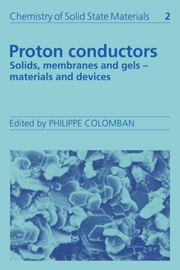Book contents
- Frontmatter
- Contents
- List of contributors
- Preface
- Symbols
- I HYDROGEN BOND AND PROTONIC SPECIES
- II MATERIALS: PREPARATION, STRUCTURES AND PROPERTIES
- III PROTON DYNAMICS AND CHARGE TRANSPORT
- IV PROTON DIFFUSION MECHANISMS
- V DEVICES
- 32 Applications of perfluorinated proton conductors (Nations)
- 33 Synthesis of polycrystalline H3O+ and NH4+ -β″/β-Al2O3 and potential applications in steam-electrolysis/fuel-cells
- 34 Fuel-cells, steam-electrolysis for hydrogen production and hydrogen separation using high temperature protonic conductors
- 35 Ice-based devices
- 36 Solid-state gas sensors operating at room temperature
- 37 All solid-state protonic batteries
- 38 Applicatios of proton conductors in electrochromic devices (ECDs)
- 39 Supercapacitors and interfacial charge accumulation devices
- Index
33 - Synthesis of polycrystalline H3O+ and NH4+ -β″/β-Al2O3 and potential applications in steam-electrolysis/fuel-cells
Published online by Cambridge University Press: 04 May 2010
- Frontmatter
- Contents
- List of contributors
- Preface
- Symbols
- I HYDROGEN BOND AND PROTONIC SPECIES
- II MATERIALS: PREPARATION, STRUCTURES AND PROPERTIES
- III PROTON DYNAMICS AND CHARGE TRANSPORT
- IV PROTON DIFFUSION MECHANISMS
- V DEVICES
- 32 Applications of perfluorinated proton conductors (Nations)
- 33 Synthesis of polycrystalline H3O+ and NH4+ -β″/β-Al2O3 and potential applications in steam-electrolysis/fuel-cells
- 34 Fuel-cells, steam-electrolysis for hydrogen production and hydrogen separation using high temperature protonic conductors
- 35 Ice-based devices
- 36 Solid-state gas sensors operating at room temperature
- 37 All solid-state protonic batteries
- 38 Applicatios of proton conductors in electrochromic devices (ECDs)
- 39 Supercapacitors and interfacial charge accumulation devices
- Index
Summary
Introduction
Proton conduction in β- and (β″-Al2O3 is of interest because of potential use in steam-electrolysis/H2/O2 fuel-cells. Single crystal H30+/-β″-Al2O3 was reported by Farrington & Briant to be a fast ion conductor with a proton conductivity of 10–4–10–5 (Ω cm)–1 at 25 °C. These encouraging results led to the first fabrication, characterization and use of polycrystalline H3O + -β″ /β-A12O32.
A second electrolyte with a higher conductivity but a lower thermal stability is NH4+ -β″-Al2032. This system, NH4+/H30+ -β″-Al203, is the best conductor of protons (σ = 7 × 10–4 (Ω cm)–1 rising to 2 × 10–2 (Ω cm)–1 at 200 °C). All previous work has been on single crystals (see Chapters 13 & 23) or powders. This chapter describes the synthesis of NH4+O + -β″-Al2O3 polycrystals.
Ion conducting structure of β″- and β-aluminas
The β-A12O3 family of compounds is constructed from oxygen and aluminium ‘spinel blocks’ with intervening ‘conduction planes’. In βA12O3 there are two spinel blocks per unit cell and in β″-A12O3 there are three. The upper oxygen layer of the spinel block is mirrored across the conduction plane in β-Al2O3 but this symmetry is lost in β″-A12O3. The alkali ion ‘Beevers-Ross’ site in the β-Al2O3 conduction planes is octahedral. The equivalent site in β″-A12O3 is tetrahedral and smaller. Thus K+ (r = 0.28 nm) promotes formation of β-A12O3 and Na+ (r = 0.196 nm), β″- A12O3.
- Type
- Chapter
- Information
- Proton ConductorsSolids, Membranes and Gels - Materials and Devices, pp. 499 - 510Publisher: Cambridge University PressPrint publication year: 1992
- 1
- Cited by



